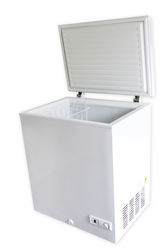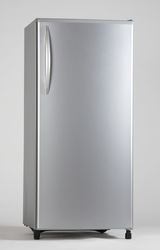Chest vs Upright Freezer
Chest Freezer
$600 - $950
(14 cu. ft. chest freezer, installed)
VS
Upright Freezer
$700 - $1,150
(14.4 cu. ft. upright freezer, installed)
Cost to install a chest or upright freezer varies greatly by region (and even by zip code).
To get free estimates from local contractors, please indicate yours.

Chest Freezer
- More storage capability
- More affordable to purchase
- Less expensive to run
- More energy-efficient
- Keeps food fresh during a power outage
- Lasts 15 to 20 years
- Fewer organizational baskets and shelves
- No auto-defrost
- Harder to clean and maintain
- Takes up more floor space
- Harder to reach items
(14 cu. ft. chest freezer, installed)
Get free advice and estimates from kitchen designers in your city.

Upright Freezer
- More organizational baskets and shelves
- Auto-defrost feature
- Requires less floor space
- Easier to clean
- Items are easier to reach
- Less space for large items
- More costly
- Faster fool spoilage during a power outage
- Lasts 10 to 15 years
(14.4 cu. ft. upright freezer, installed)
Get free advice and estimates from kitchen designers in your city.
Searching for an additional freezer can benefit the home by providing extra space for bulk sizes of meat, vegetables, and other items. Those who prepare meals ahead of time may need more space for these items. People who wish to buy in bulk to save money or to prepare for an emergency may want to have the extra space on hand. Because many refrigerators do not have large storage spaces, another freezer might be required. In this guide, we explain the differences between a chest versus an upright freezer and which may be best suited to your needs.
Appearance
Chest freezers sit horizontally on the floor and are deep in comparison to upright freezers. This may be ideal when adding food items into it, but it also means that you will have to dig for older items.
On the other hand, upright freezers look a lot like refrigerators. They stand vertically and work in the same way that a fridge does to hold the items on the various shelves and compartments. They are more space-saving than chest freezers, which makes it easier to find space in the home. They can easily slip in areas where there is less horizontal space. Chest freezers tend to be wide in length and width, making finding a spot more difficult.
Energy-efficiency
Chest freezers are more energy-efficient than upright freezers. Generally, they cost a little more than $4 a month to run when divided. Upright freezers cost around $14 a month to run. Both options come in energy-efficient models, which can further your cost savings.
Chest freezers use an airtight locking seal at the top to keep the food inside fresh and frozen. Due to this, it also means that less energy is used to keep the container cool. Upright freezers have smaller gaps in the door mechanism, which can take more energy to keep the food cold.
Also, if the power in the home goes out, chest freezers can keep food frozen for 2 to 3 days at a time. This is again due to the seal on the outside rim of the freezer. Upright freezers can only keep things frozen for one day at a time. Additionally, chest freezers have to be manually defrosted, while upright models may come with an auto-defrost option. This means that the frost is removed from the inside of the freezer. Freezers equipped with auto-defrost tend to be noisier or louder in general than those that do not have an auto-defrost. This is due to the additional air circulation, as well as to the fact that they require more energy to run, sometimes producing a louder, electrical hum.
Generally, a chest freezer needs to be unplugged, drained, and then cleaned while some upright models defrosts themselves.
Storage
Both of these freezer options are available in different sizes, which provides more or less space as required. However, the way the food is organized on the inside of the freezer makes a huge difference.
Chest freezers have only a wire basket inside them to provide organization, which means that other food items can become buried under one another. Also bending, lifting, and moving is required to find what you’re looking for. This can become tiring when you’re searching for a small bag of peas but have thrown bags of meat on top. However, due to product innovations in the freezer industry, many chest freezers now have additional storage baskets and compartments that can be used to make organization easier. Some models have drawers that can be pulled out and used for quick access. This makes using a chest freezer more bearable, although the user still has to bend over to access the items or remove baskets.
One of the benefits of using a chest freezer, however, is the ability to fit in larger items. The lack of shelves make it easier to fit in a single large item such as a turkey, and many chest freezers have up to 20% more usable space than an upright freezer. So, if you plan on storing large items, this type of freezer gives you the most utility.
Upright freezers have shelving compartments in them, much like a fridge. This provides an easy way for items to be neatly organized on different levels throughout the freezer. In the past, upright freezers were thought to be more convenient for this reason. The many shelves allow better organization, particularly if you choose a model that allows you to move the shelves to better make use of the space. Adjustable and removable door storage bins and adjustable shelving with pull out baskets can all make an upright freezer more usable. However, larger frozen items are not going to fit well in the freezer due to the shelving compartments. This reduces the space vertically, giving no room for tall items, such as a large turkey or ham.
In addition, the temperature of the doors may sometimes be warmer than the temperature inside. So, while you gain some storage on the doors, you may have a difficult time keeping everything at an even temperature.
Installation
Since a chest freezer requires more room, it is important to ensure that you have the right amount of space. Installers check to make sure there is enough headroom above it to lift the top. Additionally, there should be an electrical plug in the area for the freezer when installed.
Upright freezers require less floor space, but the door has to have enough room to swing open in the right direction. There must be at least an inch behind the freezer at all times, so it cannot be installed flush against the wall behind it. There should also be an accessible plug in the area.
Regardless of which type of freezer you choose, a pro tip is that when measuring, you add an additional inch to the width of the space. This will help accommodate air flow to the freezer, helping to prevent things like frozen coils.
Costs
The cost of materials for a 14 cubic foot chest freezer is $500 to $700 with labor costing around $100 for installation on the first floor of a home. However, installation costs can run between $100 and $250 depending on the size of the unit, floor it is going on, and any extras required. Therefore, the total cost for a 14 cubic foot chest freezer is between $600 and $950.
Material costs for a 14 cubic foot upright standard freezer is $600 to $800 with installation running between $100 and $300. Therefore, the total cost for a 14.4 cubic foot upright freezer is between $700 and $1,150.
Maintenance
Maintenance of the chest freezer is a bit more involved than that of the upright. This is mostly because the chest freezer does not have an auto-defrost option. This means thawing out the freezer, draining it, and then cleaning out the inside. Additionally, bending over and going deeper into the freezer can be tiring on the back and legs for some.
Upright freezers can be placed on the auto-defrost option and then wiped down. This takes less time and gives less of a headache and backache when cleaning out the inside of the freezer. Keep in mind, however, that it can be difficult to tell when purchasing whether an upright model has auto-defrost equipped, as many do not. You will need to specifically ask your dealer if this is an option that you desired.
Safety Concerns
Neither is safer than the other, and they both come with locking choices depending on the model. Purchasing any freezer may pose safety concerns when children are around. Children can easily open the lid to the chest freezer and climb inside, just as a child can get into the upright freezer.
Some models have locking mechanisms to make it safer for children. Locks can also be purchased and added to some models. While this is not a necessity, it is an important aspect for those with small children to consider when purchasing a freezer.
Lifespan
Chest freezers tend to have longer lifecycles than upright choices because of the way they are made. They do not overheat, do not have issues with leaking fluids, and are built with long-term use in mind. Chest freezers are expected to last between 15 and 20 years, while upright freezers have a life expectancy of 10 to 15 years.
Freezer Burn
Chest freezers tend to keep food at a more consistent temperature than upright freezers. This means that you can theoretically leave things frozen for longer periods of time without issue.This is because of their need for manual defrosting; there is less air circulating through the freezer, which keeps freezer burn to a minimum. In addition, there is no food stored on the door, which can be a different temperature than the interior.
Upright freezers that have been equipped with auto-defrost often have more air circulation. While this means that they’re lower in maintenance, it also means that food stored in them is more prone to developing freezer burn or the accumulation of ice crystals. Temperatures are also not as consistent, so you may not be able to leave food in an upright freezer for as long a period of time.
How much does it cost to install a chest or upright freezer in my city?
Cost to install a chest or upright freezer varies greatly by region (and even by zip code).
To get free estimates from local contractors, please indicate yours.